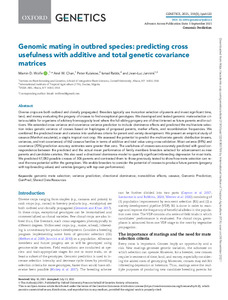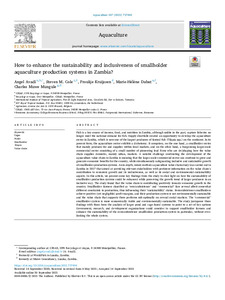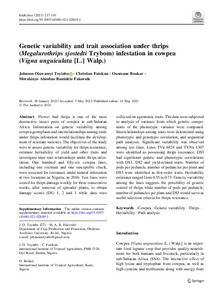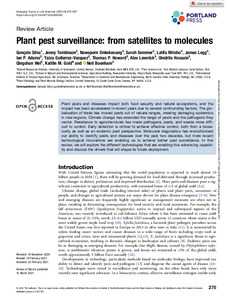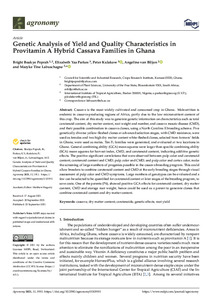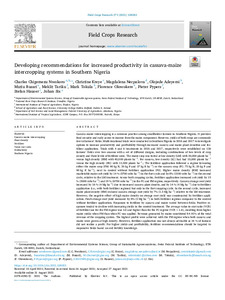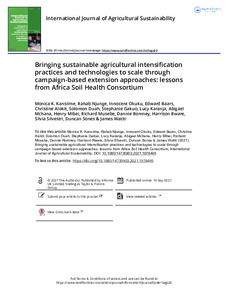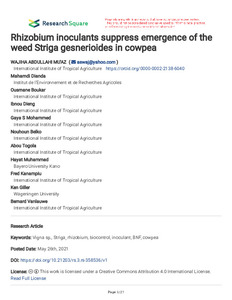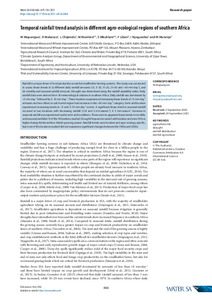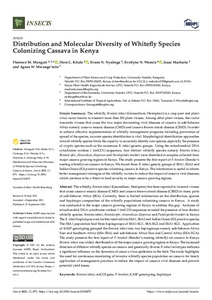Welcome to the International Institute of Tropical Agriculture Research Repository
IITA Bibliography System: Recent submissions
Now showing items 1141-1160 of 7933
-
Genomic mating in outbred species: predicting cross usefulness with additive and total genetic covariance matrices
(2021)Diverse crops are both outbred and clonally propagated. Breeders typically use truncation selection of parents and invest significant time, land, and money evaluating the progeny of crosses to find exceptional genotypes. We developed and tested genomic mate selection criteria suitable for organisms of arbitrary homozygosity level where the full-sibling progeny are of direct interest as future parents and/or cultivars. We extended cross variance and covariance variance prediction to include dominance ... -
Beyond ''women's traits'': exploring how gender, social difference and household characteristics influence trait preferences
(2021)Demand-led breeding strategies are gaining importance in public sector breeding globally. While borrowing approaches from the private sector, public sector programs remain mainly focused on food security and social impact related outcomes. This necessitates information on specific user groups and their preferences to build targeted customer and product profiles for informed breeding decisions. A variety of studies have identified gendered trait preferences, but do not systematically analyze ... -
How to enhance the sustainability and inclusiveness of smallholder aquaculture production systems in Zambia?
(2022-01-30)Fish is a key source of income, food, and nutrition in Zambia, although unlike in the past, capture fisheries no longer meet the national demand for fish. Supply shortfalls created an opportunity to develop the aquaculture sector in Zambia, which is now one of the largest producers of farmed fish (Tilapia spp.) on the continent. In its present form, the aquaculture sector exhibits a dichotomy. It comprises, on the one hand, a smallholder sector that mainly produces for and supplies within local ... -
Continuous mapping identifies Loci associated with weevil resistance [Cosmopolites sordidus (Germar)] in a triploid banana population
(2021)The first step towards marker-assisted selection is linking the phenotypes to molecular markers through quantitative trait loci (QTL) analysis. While the process is straightforward with self-pollinating diploid species, QTL analysis in polyploids requires unconventional methods. In this study, we have identified markers associated with weevil Cosmopolites sordidus (Germar) resistance in banana using 138 triploid (2n = 3x) hybrids derived from a cross between a tetraploid ‘Monyet’ (2n = 4x) and a ... -
Genetic variability and trait association under thrips (Megalurothrips sjostedti Trybom) infestation in cowpea (Vigna unguiculata [L.] Walp.)
(2021)Flower bud thrips is one of the most destructive insect pests of cowpea in sub-Saharan Africa. Information on genetic variability among cowpea germplasm and interrelationships among traits under thrips infestation would facilitate the development of resistant varieties. The objectives of the study were to assess genetic variability for thrips resistance, estimate heritability of yield and other traits and investigate inter-trait relationships under thrips infestation. One hundred and fifty-six ... -
Genome-wide association study of root mealiness and other texture-associated traits in cassava
(2021)Cassava breeders have made significant progress in developing new genotypes with improved agronomic characteristics such as improved root yield and resistance against biotic and abiotic stresses. However, these new and improved cassava (Manihot esculenta Crantz) varieties in cultivation in Nigeria have undergone little or no improvement in their culinary qualities; hence, there is a paucity of genetic information regarding the texture of boiled cassava, particularly with respect to its mealiness, ... -
Plant pest surveillance: from satellites to molecules
(2021)Plant pests and diseases impact both food security and natural ecosystems, and the impact has been accelerated in recent years due to several confounding factors. The globalisation of trade has moved pests out of natural ranges, creating damaging epidemics in new regions. Climate change has extended the range of pests and the pathogens they vector. Resistance to agrochemicals has made pathogens, pests, and weeds more difficult to control. Early detection is critical to achieve effective control, ... -
Genetic analysis of yield and quality characteristics in provitamin A hybrid cassava families in Ghana
(2021)Cassava is the most widely cultivated and consumed crop in Ghana. Malnutrition is endemic in cassava-producing regions of Africa, partly due to the low micronutrient content of this crop. The aim of this study was to generate genetic information on characteristics such as total carotenoid content, dry matter content, root weight and number, and cassava mosaic disease (CMD), and their possible combination in cassava clones, using a North Carolina II breeding scheme. Five genetically diverse ... -
Genetic diversity of local and introduced cassava germplasm in Burundi using DArTseq molecular analyses
(2022-01-24)In Burundi most small-scale farmers still grow traditional cassava landraces that are adapted to local conditions and have been selected for consumer preferred attributes. They tend to be susceptible, in varying degrees, to devastating cassava viral diseases such as Cassava Brown Streak Disease (CBSD) and Cassava Mosaic Disease (CMD) with annual production losses of US$1 billion. For long term resistance to the disease, several breeding strategies have been proposed. A sound basis for a breeding ... -
Potential of genomics for the improvement of underutilized legumes in sub-Saharan Africa
(2021)Underutilized, or orphan legumes, are widely distributed across farming landscapes in sub-Saharan Africa (SSA) but often have low yields and do not fulfill their potential due to very limited research, breeding, development, marketing, and awareness of their benefits. These advantages include nutritional quality and climate resilience. In this review, we focus on Bambara groundnut, African yam bean, and Kersting's groundnut. Knowledge of the challenges and rewards of exploiting them will provide ... -
On-farm assessment of cassava root yield response to tillage, plant density, weed control and fertilizer application in southwestern Nigeria
(2021)Cassava is growing in importance in Nigeria as a food and industrial crop. Current yields are low due to poor soil fertility and because farmers do not use improved germplasm, clean planting material, or improved crop management in Nigeria. To provide feasible agronomic recommendations targeting increased root yield, the effects of tillage intensity, fertilizer application, plant density and weed control were tested in 230 farmers’ fields in southwestern Nigeria over two years. In 2016, tillage ... -
Preliminary assessment of the association between DArT-SEQ SNP and some nutritional traits in African yam bean
(2021)African yam bean (AYB) is an underutilized tropical legume rich in protein and starch content. This study's aim was to use Diversity Arrays Technology (DArT) sequencing to study the ge-nome-wide association studies (GWAS) of nutritional traits. The study was carried out on 137 accessions in IITA, Ibadan. Seeds were harvested at maturity and analysed for protein, oil, and starch using Kjeltec, Soxtec, and Phenol-sulfuric acid assay method. Mixed Linear Model (MLM) was used for GWAS analysis by ... -
Banana seed genetic resources for food security: status, constraints, and future priorities
(2021)Storing seed collections of crop wild relatives, wild plant taxa genetically related to crops, is an essential component in global food security. Seed banking protects genetic resources from degradation and extinction and provides material for use by breeders. Despite being among the most important crops in the world, banana and plantain crop wild relatives are largely under-represented in genebanks. Nevertheless, banana crop wild relative seed collections are in fact held in different countries, ... -
Developing recommendations for increased productivity in cassava-maize intercropping systems in southern Nigeria
(2021)Cassava-maize intercropping is a common practice among smallholder farmers in Southern Nigeria. It provides food security and early access to income from the maize component. However, yields of both crops are commonly low in farmers’ fields. Multi-locational trials were conducted in Southern Nigeria in 2016 and 2017 to investigate options to increase productivity and profitability through increased cassava and maize plant densities and fertilizer application. Trials with 4 and 6 treatments in 2016 ... -
Bringing sustainable agricultural intensification practices and technologies to scale through campaign-based extension approaches: lessons from Africa Soil Health Consortium
(2021)Sustainable agricultural intensification (SAI) practices have been developed with the aim of increasing agricultural productivity. However, most of them are not achieving their potential because of low adoption, linked to limited extension support to make them known and accessible by end-users. This paper reviews the effectiveness of the Africa Soil Health Consortium (ASHC) extension-based campaigns, contributing knowledge for formulating novel and cost-effective extension approaches. Results show ... -
Rhizobium inoculants suppress emergence of the weed Striga gesnerioides in cowpea
(2021)Cowpea is a grain legume of major importance in sub-Saharan Africa where it is cultivated by smallholder farmers on poor soils and production is often constrained by the parasitic weed Striga gesnerioides. Experiments were conducted to assess the potential of rhizobium inoculation in mitigating Striga infestation and increasing cowpea productivity. We tested under basal P application and artificial S. gesnerioides inoculation the impact of cowpea genotypes (G) (nine Striga-resistant and 11 Striga– ... -
Genetic diversity in cowpea [Vigna unguiculata (L.) Walp.] accessions collected from Togo
(2021-11)Cowpea is one of the most widely grown legumes in Togo for its grains and leaves, which are used both as food and feed. Despite its importance in the nutrition and economic life of the people, bulk of the varieties grown in Togo are landraces. Genetic improvement of crops requires the presence of heritable genetic variation. However, there is hardly any information on the extent of variability among cultivated cowpea in Togo. This study was carried out to assess the phenotypic and molecular diversity ... -
Temporal rainfall trend analysis in different agro-ecological regions of southern Africa
(2021-10)Rainfall is a major driver of food production in rainfed smallholder farming systems. This study was conducted to assess linear trends in (i) different daily rainfall amounts (<5, 5–10, 11–20, 21–40 and >40 mm∙day-1), and (ii) monthly and seasonal rainfall amounts. Drought was determined using the rainfall variability index. Daily rainfall data were derived from 18 meteorological stations in southern Africa. Daily rainfall was dominated by <5 mm∙day-1 followed by 5–10 mm∙day -1. Three locations ... -
Mechanisms and approaches towards enhanced drought tolerance in cassava (Manihot esculenta)
(2021)Cassava (Manihot esculenta Crantz) is cultivated in tropical and subtropical regions for its edible tuberous roots and minimally for its leaves. It provides food and revenue to over eight hundred million people particularly in Africa. Generally, cassava is drought-tolerant, and sheds leaves in drought conditions resulting in significantly lower yields. Cassava drought management strategies need to focus on maximizing the utilization of molecular tools for crop establishment and yield. Developing ... -
Distribution and molecular diversity of whitefly species colonizing cassava in Kenya
(2021)The whitefly, Bemisia tabaci (Gennadium, Hemiptera) has been reported to transmit viruses that cause cassava mosaic disease (CMD) and cassava brown streak disease (CBSD) in many parts of sub-Saharan Africa (SSA). Currently, there is limited information on the distribution, species and haplotype composition of the whitefly populations colonizing cassava in Kenya. A study was conducted in the major cassava growing regions of Kenya to address this gap. Analyses of mitochondrial DNA cytochrome oxidase ...

